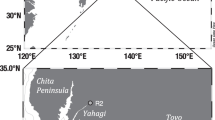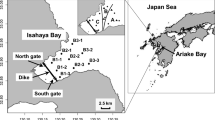Abstract
Bottom water hypoxic events were observed in Narragansett Bay, Rhode Island during the summer of 2001 using a towed sensor, vertical casts at fixed stations, and continuous monitoring buoys. This combination of approaches allowed for both extensive spatial and temporal sampling. Oxygen concentrations below the U.S. Environmental Protection Agency (EPA) acute hypoxia criterion of 2.3 mg l−1 were observed in the northern parts of Narragansett Bay, including the Providence River. We estimate 39% of the area of the Providence River was affected by acute hypoxia between July and September 2001. All other regions experienced only small areas of acute hypoxia (<5%), and no acute hypoxia was observed from Quonset Point south. The area encompassing oxygen concentrations below the EPA chronic hypoxia criterion of 4.8 mg l−1 was much more extensive in the upper half of Narragansett Bay, sometimes covering the majority of the region, though it is unclear whether exposure to concentrations below this criterion persisted long enough to significantly affect marine species in these areas. Vertical profiles of dissolved oxygen typically exhibited a mid water oxygen minimum near the pycnocline, followed by a slight increase in oxygen with depth. The surface waters above the pycnocline were typically supersaturated with oxygen. The northern portions of the Bay where the most extensive hypoxia was observed corresponded to the regions with both the greatest thermohaline stratification, the highest nutrient inputs, and the highest primary productivity.
Similar content being viewed by others
Literature Cited
Anderson, T. H. andG. T. Taylor. 2001. Nutrient pulses, plankton blooms, and seasonal hypoxia in western Long Island Sound.Estuaries 24:228–243.
Bergondo, D. L., D. R. Kester, H. E. Stoffel, andW. L. Woods. 2005. Time-series observations during the low sub-surface oxygen events in Narragansett Bay during summer 2001.Marine Chemistry 97:90–103.
Berman, M. S. andK. Sherman. 2001. A towed body sampler for monitoring marine ecosystems.Sea Technology 42:48–52.
Carey, D., A. Desbonnet, A. B. Colt, andB. A. Costa-Pierce. 2005. State of Science on Nutrients in Narragansett Bay: Findings and Recommendations from the Rhode Island Sea Grant 2004 Science Symposium. Rhode Island Sea Grant, Kingston, Rhode Island.
Chinman, R. A. and S. W. Nixon. 1985. Depth-Area-Volume Relationships in Narragansett Bay. National Oceanic and Atmospheric Administration/Sea Grant Technical Report 87. Kingston, Rhode Island.
Deacutis, C. F., D. Murray, W. Prell, E. Saarman, and L. Korhun. 2006. Natural and anthropogenic influences on the Mount Hope Bay ecosystem: Concluding remarksNortheastern Naturalist 13.
Kremer, J. N. andS. W. Nixon. 1978. A Coastal Marine Ecosystem: Simulation and Analysis, 1st edition. Springer Verlag, New York.
Levine, E. 1972. The Tidal Energetics of Narragansett Bay. M.S. Thesis, University of Rhode Island, Kingston, Rhode Island.
Magnuson, A. 1997. Chemical Variability in Mixed Laver Waters. Ph.D. Dissertation, University of Rhode Island, Kingston, Rhode Island.
Nixon, S. W., S. L. Granger, andB. L. Nowicki. 1995. An assessment of the annual mass balance of carbon nitrogen and phosphorus in Narragansett Bay.Biogeochemistry 31:15–61.
Ovaitt, C., A. Keller, andL. Reed. 2002. Annual primary production in Narragansett Bay with no bay-wide winter-spring phytoplankton bloom.Estuarine Coastal and Shelf Science 54: 1013–1026.
Parker, C. A. andJ. E. O'Reilly. 1991. Oxygen depletion in Long Island Sound: A historical perspective.Estuaries 14:248–264.
Rhode Island Department of Environmental Management (RIDEM). 2003. The Greenwich Bay Fish Kill-August 2003, Causes, Impacts, and Responses. Rhode Island Department of Environmental Management, Providence, Rhode Island.
Strickland, J. D. andT. R. Parsons. 1972. A Practical Handbook of Seawater Analysis. Bulletin of the Fisheries Research Board of Canada, 2nd edition. Queens Printer, Ottawa, Canada.
U.S.Environmental Protection Agency (USEPA). 2000. Ambient Aquatic Life Water Quality Criteria for Dissolved Oxygen (Saltwater): Cape Cod to Cape Hatteras. USEPA, Washington D.C.
U.S.Public Health Service (USPHS). 1960. Effects of Proposed Hurricane Barriers on Water Quality of Narragansett Bay. USPHS, New York.
Valente, R. M., D. C. Rhoads, J. D. Germano, andV. J. Cabelli. 1992. Mapping of benthic enrichment patterns in Narragansett Bay, Rhode Island.Estuaries 15:1–17.
Welsh, B. L. andF. C. Eller. 1991. Mechanisms controlling summertime oxygen depletion in western Long Island Sound.Estuaries 14:265–278.
Author information
Authors and Affiliations
Corresponding author
Rights and permissions
About this article
Cite this article
Melrose, D.C., Oviatt, C.A. & Berman, M.S. Hypoxic events in Narragansett Bay, Rhode Island, during the summer of 2001. Estuaries and Coasts: J ERF 30, 47–53 (2007). https://doi.org/10.1007/BF02782966
Received:
Revised:
Accepted:
Issue Date:
DOI: https://doi.org/10.1007/BF02782966




